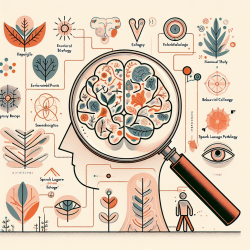Introduction
The understanding of autism spectrum disorders (ASD) has evolved significantly over the years, with various theories attempting to explain its origins and characteristics. One such intriguing perspective is the "Solitary Forager Hypothesis," which suggests that certain genes associated with autism may have been naturally selected due to their adaptive benefits in ancestral environments. This blog delves into this hypothesis, exploring its implications for practitioners in the field of speech-language pathology and online therapy services like those provided by TinyEYE.
The Solitary Forager Hypothesis
The Solitary Forager Hypothesis posits that some genes linked to autism were advantageous in prehistoric times, particularly for individuals who thrived in solitary foraging environments. This theory suggests that the cognitive and behavioral traits observed in individuals on the autism spectrum may have been adaptations that facilitated self-sufficiency and resource acquisition in environments where social interaction was less critical.
Key Findings and Implications
- Adaptive Traits: The hypothesis highlights traits such as systemizing abilities, repetitive behaviors, and a preference for routine as potentially advantageous for solitary foraging. These traits, often seen as challenges in modern social contexts, could have been beneficial for survival and resource acquisition in the past.
- Neurobiological Insights: Research indicates that individuals with autism may have enhanced abilities in areas like spatial awareness and systemizing, which could have been crucial for navigating and thriving in solitary environments.
- Social Interaction: The hypothesis suggests that while individuals on the autism spectrum may have been less socially inclined, they could still form functional relationships and contribute valuable skills to small groups or communities.
Practical Applications for Practitioners
For practitioners in speech-language pathology and online therapy services, understanding the Solitary Forager Hypothesis can provide valuable insights into the unique strengths and challenges faced by individuals with autism. By recognizing the potential adaptive nature of certain traits, practitioners can tailor their therapeutic approaches to leverage these strengths, fostering greater independence and self-sufficiency in their clients.
Encouraging Further Research
While the Solitary Forager Hypothesis offers a compelling perspective on the evolution of autism, it is essential to continue exploring this theory through further research. By examining the genetic, neurological, and behavioral aspects of autism from an evolutionary standpoint, researchers can gain deeper insights into its origins and develop more effective interventions.
Conclusion
The Solitary Forager Hypothesis provides a fascinating lens through which to view autism, challenging traditional perceptions and highlighting the potential adaptive nature of certain traits. For practitioners, embracing this perspective can lead to more personalized and effective therapeutic approaches, ultimately improving outcomes for individuals on the autism spectrum.
To read the original research paper, please follow this link: Conceptualizing the Autism Spectrum in Terms of Natural Selection and Behavioral Ecology: The Solitary Forager Hypothesis.










